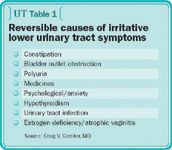Article
OAB: Treatment with existing and newer oral agents
Antimuscarinics are recommended as first-line pharmacotherapy for OAB. They act to reduce urgency, stabilize detrusor overactivity, and increase bladder capacity.

While a number of modalities are available to treat OAB, oral anticholinergic medications remain the mainstay of treatment. After providing an overview of the etiology of OAB and the evaluation of symptomatic patients, this article discusses pharmacologic therapy, including the growing number of anticholinergic medications and promising newer agents currently under investigation.

Normally, myelinated A-delta sensory fibers respond to stretch and contraction of the detrusor. Unmyelinated C-fiber nociceptors in the subepithelium, lamina propria, and smooth muscle are relatively silent during normal storage and voiding. Under certain pathologic states, these nociceptors become mechanosensitive, with a decreased activation threshold in response to inflammation, obstruction, and chemical stimuli. This enhanced transmission to the sacral cord results in symptoms of frequency, urgency, urge incontinence, and even pelvic pain.
A myogenic pathophysiology is suggested by the observation of increased cell-cell junctions in electron micrographic studies of detrusor specimens from patients with urgency incontinence (J Urol 1993; 150:1668-80). With increased electrical coupling, a coordinated unstable detrusor contraction is more likely to propagate.The urothelium functions not only as a barrier, but also in sensory transduction. Urothelial cells express receptors for adrenergic, muscarinic, nicotinic, and vanilloid neurotransmitters. Muscarinic and adrenergic urothelial stimulation mediates adenosine triphosphate and nitric oxide release, which modulates smooth muscle as well as afferent nerve activity via purinoceptors and vanilloid receptors.
In addition to the detrusor muscle and urothelium, other mediators of storage and voiding have been identified. Interstitial cells lie in close proximity to nerves and smooth muscle cells, and respond to cholinergic agonists, propagating signals that cause detrusor contraction. Myofibroblasts lie adjacent to bare nerve endings in the lamina propria. These mechanoreceptors are activated by stretch and communicate with smooth muscle cells via intercellular junctions.

Treatment Behavioral modification (fluid restriction, caffeine restriction, timed urination, bladder retraining, and pelvic floor exercises) should be offered to all patients. Pharmacotherapy should not be offered in isolation, because combined pharmacotherapy and behavioral modification have been shown to be more efficacious than either modality alone (J Am Geriatr Soc 2000; 48:370-4).



